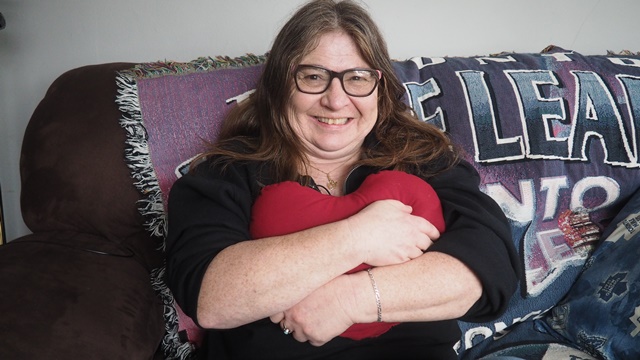By Jessie Boogaard and Melicent Lavers-Sailly
Heather Stevens has rarely gotten a good break when it comes to her health.
Even as a child, she remembers fatigue as her constant companion.
First diagnosed in her teens with a congenital heart problem — the need for a pacemaker finally became obvious.
“I had two children and then, just before my 25th birthday, I started passing out,” she said. “I passed out at home one time with my daughter standing over me saying ‘Mommy, mommy, mommy, wake up.’”
For 33 years, Heather’s pacemakers helped keep her healthy. She received new ones when necessary, earning a special nickname, “Ticker,” from her friends.
But things didn’t go well in 2017, when a life-threatening infection developed after a pacemaker replacement procedure.
“I kept getting sick and the pains in my chest were unreal. I was giving up and I didn’t think I was going to make it,” she said.
Heather needed open heart surgery to remove the new pacemaker, its leads, and the infection. But what happened next was made possible because of a new approach to purchasing by Ontario hospitals called “innovative procurement”.
In Canada’s single-payer health system, buying medical products or services has traditionally focused primarily on lowest price.
But at Southlake Regional Health Centre in Newmarket, Ontario, the Regional Cardiac Care Program recently experimented with an approach that supporters say could revolutionize Canadian healthcare.
“Traditional procurement strategies were trying to achieve the lowest price for the products,” said Janice Allen, director, Regional Cardiac Care Program at Southlake Regional Health Centre. “Whereas we were looking for a strategy that would not only achieve value for money but would also achieve our goal of adopting new innovation into our heart program.”
Under “innovative procurement,” Southlake was able to consider the value of a product or service, in addition to its price. They could discuss whether a product improves outcomes for patients, helps them recover faster, go home sooner or reduce their risk of returning to the hospital. They could also consider whether a medical device lasts longer than others, or is more appropriate for a patient’s particular condition.
In order to achieve innovative procurement, Southlake engaged in “competitive dialogue,” which allowed it to partner with companies to find ways of improving operational efficiency or streamline medical procedures. The savings could then be used in several ways, including investing in new medical technologies.
The experiment came with permission and a grant from the Ontario Ministry of Government and Consumer Services.
“I think if any of us stood in front of a whiteboard and redesigned the delivery of healthcare in Ontario, we would focus on competitive dialogue and innovative procurement,” said Bill Charnetski, chief health innovation strategist for the province of Ontario. “These have the potential, if used across the system, to enhance the focus on patient outcomes and come to the appropriate method of getting to those outcomes at the right cost, measured across the patient journey through the system.”
Thanks to innovative procurement and competitive dialogue, Southlake’s Heart Rhythm team was able to implant a leadless pacemaker to help Heather. Because it’s implanted inside the heart without traditional surgery, and because it has no leads connecting it to the heart, the risk of infection for Heather was much lower. But under Ontario’s standard approach to procurement, she likely would have received another traditional pacemaker, or been forced to go to another hospital hours from home.
“This whole process not only benefits our institution and the Ministry in terms of funding, but it also benefits the patients,” said Dr. Zaev Wulffhart, physician leader of the Regional Cardiac Care Program at Southlake. “Giving our patients the best advantage is the most significant thing we can achieve.”
Dr. Wulffhart explains that partnerships with healthcare companies will be important to the success of such programs. “Our relationships with industry have to change. We have to stop thinking of them as vendors and more as partners in care. They all have a commitment to a better quality of life for their patients, just as we do,” he said.
Heather is now back at work and back to enjoying life with her family and friends. She had never heard of innovative procurement, but she appreciates what it’s done for her. And she hopes other Canadians will soon benefit from it too.
”I feel great. Better than I have in a long time. To go from feeling poorly to feeling like a million dollars, is priceless. That’s the only word.”
Jessie Boogaard is Manager, Business and Quality, Regional Cardiac Care Program at Southlake Regional Health Centre. Melicent Lavers-Sailly is Senior Manager, Communications & Corporate Marketing at Medtronic Canada and a Member of the TOHealth! Marketing Working Group.


